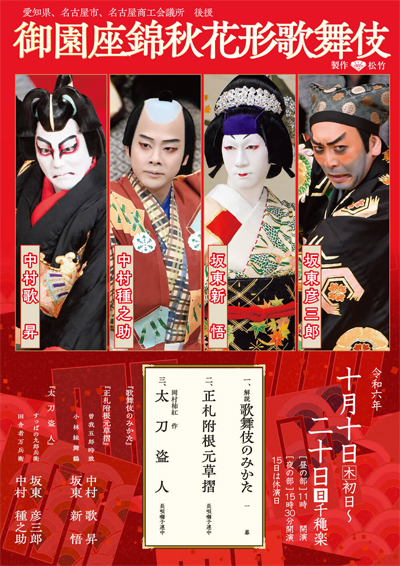| OCTOBER 2024 |
| Kabukiza (T˘ky˘) |  |
| Dates | 2 ~ 26 October 2024 Kinshű Jűgatsu ďkabuki Autumn Brocade October Grand Kabuki |
| MatinÚe |
Heike Nyogo no Shima (Shunkan) Oto-ni Kiku Soga no Irodori |
| Evening |
Onna Keizu Genji Monogatari |
| Casting |
Living National Treasure Onoe Kikugor˘, Living National Treasure Kataoka Nizaemon, Living National Treasure Band˘ Tamasabur˘, Living National Treasure Nakamura T˘z˘, Living National Treasure Nakamura Karoku, Nakamura Manju, Nakamura Shikan, Onoe Kikunosuke, Nakamura Kaishun, Onoe Sh˘roku, Nakamura Shid˘, Band˘ Minosuke, Onoe Ukon, Nakamura Matagor˘, Band˘ Yajűr˘, Kamimura Kichiya, Nakamura Tokiz˘, Band˘ Kamez˘, Ichikawa Somegor˘, Nakamura Mantar˘, Kawarasaki Gonjűr˘, Nakamura Matsue, Nakamura Kikaku, Nakamura Hashinosuke, Nakamura Kamenoj˘, Nakamura Kichinoj˘, Kataoka Matsunosuke, Ichimura Kitsutar˘, Onoe Sakon, Onoe Maholo, Kamimura Kichitar˘, Taguchi Mamoru |
| Comments |
The October Grand Kabuki at the Kabukiza.
|
 |
 |
| Sh˘chikuza (ďsaka) |  |
| Dates | 10 ~ 26 October 2024 Jűgatsu ďkabuki October Grand Kabuki |
| MatinÚe | |
| Evening |
Yoshitsune Senbon Zakura |
| Casting |
Ichikawa Danjűr˘, Ichikawa Shinnosuke, Living National Treasure Nakamura Baigyoku, Nakamura Ganjir˘, Nakamura Senjaku, Nakamura Jakuemon, Matsumoto K˘shir˘, Kataoka Takatar˘, Ichikawa Udanji, Nakamura Kotar˘, Ichikawa Omez˘, Ichikawa Komaz˘, Kataoka Ichiz˘, Matsumoto Kingo, Ichikawa Kudanji, ďtani Hiromatsu, Nakamura Toranosuke, Nakamura Kangyoku, Ichikawa Otora, Nakamura Tamatar˘ |
| Comments |
The shűmei of Ichikawa Danjűr˘ XIII and the hatsubutai of Ichikawa Shinnosuke VIII in ďsaka at the Sh˘chikuza.
|
 |
 |
| Misonoza (Nagoya) |  |
| Dates | 10 ~ 20 October 2024 Misonoza Kinshű Hanagata Kabuki Misonoza Autumn Brocade Young Actors Kabuki |
| Program |
Kabuki no Mikata |
| Casting |
Band˘ Hikosabur˘, Nakamura Kash˘, Band˘ Shingo, Nakamura Tanenosuke |
| Comments |
No classic October kaomise programs in Nagoya at the Misonoza this year but a special Kabuki program starring young actors.
|
 |
|
|||
| Dates | 8 ~ 22 October 2024 | ||
| Program |
Yamato Takeru |
||
| Casting |
Nakamura Kinnosuke, Ichikawa Chűsha, Nakamura Hayato, Ichikawa Danko, Nakamura Kazutar˘, Nakamura Yonekichi, Ichikawa Monnosuke, Ichikawa Emisabur˘, Ichikawa Emiya, Ichikawa En'ya, Ichikawa Juen, Ichikawa Seiko, Nakamura Fukunosuke, Nakamura Utanosuke, Kashima Noritoshi |
||
| Comments |
Revival of the famous SűpÔ Kabuki drama "Yamato Takeru", a classic of the Omodakaya guild, in Fukuoka at the Hakataza. In the absence of Ichikawa Ennosuke, the eponymous role of Yamato Takeru is played by either Ichikawa Ennosuke III's grandson Ichikawa Danko or Nakamura Hayato.
|
||
 |
 |
 |
| Kinshű Special Tour | |
| Dates | 2 ~ 20 October 2024 Kinshű Tokubetsu K˘en Autumn Brocade Special Performances |
| Program |
T˘ku K˘nÔ Wakazuru Irodori Kis˘ Sato Geshiki Bukaku Goj˘bashi |
| Casting |
Nakamura Kankur˘, Nakamura Shichinosuke, Nakamura Tsurumatsu, Nakamura Sanzaemon, Nakamura Ich˘, Sawamura Kunihisa, Nakamura Nakasuke, Nakamura Nakashir˘, Nakamura Nakaji, Nakamura Nakaya |
| Comments |
The word kinshű means "Autumn Brocade". This Autumn tour in 11 cities stars Nakamura Kankur˘ and Nakamura Shichinosuke. The first item in the program, entitled T˘ku K˘nÔ (literally 'Talk Corner') is a speech/presentation on stage about some aspects of Kabuki. This tour commemorates the 12th anniversary (13th memorial service) of the passing away of Nakamura Kanzabur˘ XVIII.
|
 |
| Sh˘chiku Grand Kabuki Tour | |
| Dates | 31 October ~ 25 November 2024 Sh˘chiku ďkabuki Sh˘chiku Grand Kabuki |
| Program |
Goaisatsu |
| Casting |
Nakamura Kinnosuke, Nakamura Hayato, Kamimura Kichiya, Ichikawa Emisabur˘, Ichikawa Seiko, Kamimura Kichitar˘, Kamimura Orinosuke |
| Comments |
The Sh˘chiku Grand Kabuki Fall Tour in 20 cities.
|
 |
|
|
| Contact | Main | Top | Updates | Actors | Plays | Playwrights | Programs | Links | FAQ | Glossary | Chronology | Illustrations | Prints | Characters | Derivatives | Theaters | Coming soon | News |
